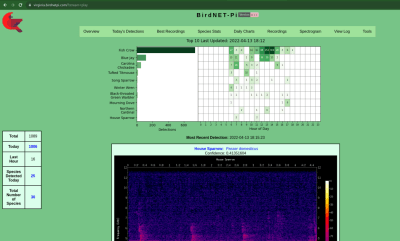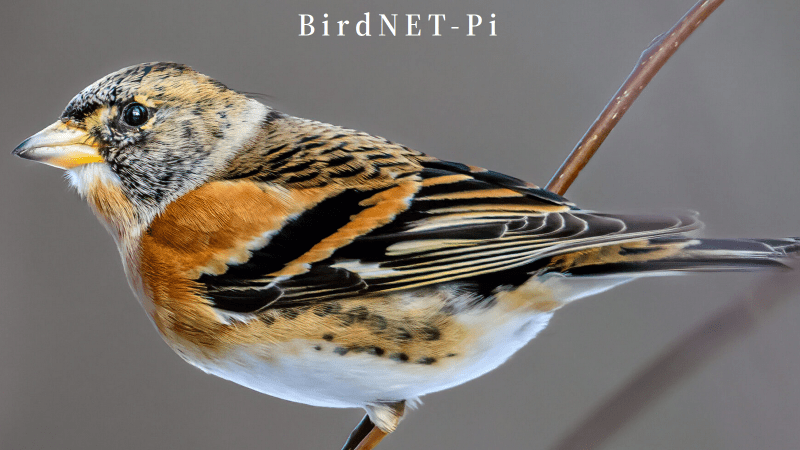Recently, we’ve stumbled upon the extensive effort that is the BirdNET research platform. BirdNET uses a neural network to identify birds by the sounds they make, and is a joint project between the Cornell Lab of Ornithology and the Chemnitz University of Technology. What strikes us is – this project is impressively featureful and accessible for a variety of applications. No doubt, BirdNET is aiming to become a one-stop shop for identifying birds as they sing.
There’s plenty of ways BirdNET can help you. Starting with likely the most popular option among us, there are iOS and Android apps – giving the microphone-enabled “smart” devices in our pockets a feature even the most app-averse hackers can respect. However, the BirdNET team also talks about bringing sound recognition to our browsers, Raspberry Pi and other SBCs, and even microcontrollers. We can’t wait for someone to bring BirdNET to a RP2040! The code’s open-source, the models are freely available – there’s hardly a use case one couldn’t cover with these.
 About that Raspberry Pi version! There’s a sister project called BirdNET-Pi – it’s an easy-to-install software package intended for the Raspberry Pi OS. Having equipped your Pi with a USB sound card, you can make it do 24/7 recording and analysis using a “lite” version of BirdNET. Then, you get a web interface you can log into and see bird sounds identified in real-time. Not just that – BirdNET-Pi also processes the sounds and creates spectrograms, keeps the sound in a database, and can even send you notifications.
About that Raspberry Pi version! There’s a sister project called BirdNET-Pi – it’s an easy-to-install software package intended for the Raspberry Pi OS. Having equipped your Pi with a USB sound card, you can make it do 24/7 recording and analysis using a “lite” version of BirdNET. Then, you get a web interface you can log into and see bird sounds identified in real-time. Not just that – BirdNET-Pi also processes the sounds and creates spectrograms, keeps the sound in a database, and can even send you notifications.
The BirdNET-Pi project is open, too, of course. Not just that – the BirdNET-Pi team emphasizes everything being fully local, unless you choose otherwise, and perhaps decide to share it with others. Many do make their BirdNET-Pi instances public, and there’s a lovely interactive map that shows bird sounds all across the world!
BirdNET is, undoubtedly, a high-effort project – and a shining example of what a dedicated research team can do with a neural network and an admirable goal in mind. For many of us who feel joy when we hear birds outside, it’s endearing to know that we can plug a USB sound card into our Pi and learn more about them – even if we can’t spot them or recognize them by sight just yet. We’ve covered bird sound recognition on microcontrollers before – also using machine learning.
















Wow, getting to that plateu of productivity at last, as AI answers the great questions, like “Is it a bird? Is it a plane?”
“Is it a tank or APC, should a charge go 0.3 or 3s from now”
Interesting. My problem\project idea is to have a Pi recognize the calls of just two birds and then play the alarm call of the same species. Ya see….I have two Gila Woodpeckers ,(mating pair) that call my general area home. They SCEETCH all bloody day long. Come March, they have a couple of eggs and the chicks with made even more annoying noise for a week or so. One sibling will try and tech the other to fly…way too soon..and then the winner will keep screening for food from sun up to sun down. BTW… It isn’t teaching it to fly. It’s straight up murder for more food. Nice…huh?
In the infinite wisdom of our fed govt, they are protected by the migratory bird act. Yet…they don’t migrate!!!! All year long they are here.
I’ve found what I think is an alarm call on Merlin from Cornell lab. Basically the same type of mobile app. It IDs bird calls. Now…I just need to get a library maybe for python that when it’s detected, it plays the alarm code and…the drumming audio of a male. Maybe they will. Move? Plenty of saguaro cactus and palm trees in the city for them to live in…lol.
My very first through is can it hacked to become a local become HumanNET
(To identify humans just by their knocks e.g. “shave and a haircut … two bits” https://www.youtube.com/watch?v=4W3cPSntmBk ).
Not hotdog
Great reference!
Been using it for quite a while… Works good… Sometimes can identify multiple birds at once
…until they encounter wild parrots of florida, that can mimic almost anything. sort of just wanna find a flock of them and train them to make weird ass sounds and cuss words so they can fly all over florida insulting humans.
Forget the RPi unless you already have one. You may find that the cheapest android device on the market, those ones that are locked to a particular network, are the most cost effective way of running this code because you don’t need the SIM card or phone contract as they work fine over wireless networks. You can also run the IP Cam app on them, add one of those solar powered charging packs for extended life. Even if you do need a longer range a LoStik USB LoRa device would pay for itself soon enough, fine for just sending the text output of the recogniser.
Four and twenty birds baked in a Pi?
The pi was opened when the birds began to sing
I can confirm the app is quite good, and the spectrogram/voice print display always reminds me that I wish I had a voice print app/tool handy and active more often. There’s something fun about seeing what you’re hearing. The always on pi project sounds neat though my server pi is already overworked, maybe the same basic code can run on an old “thin client” based server.
Wait, people on earth can still get hold of Raspberry Pis? I thought there’s a shortage.
Nobody drives in New York, there’s too much traffic.
We had a good laugh when a friend of mine tried to imitate a bird to the app and birdnet identified it as „human“
Hah, nice
I did similar project 2 years ago: https://hackaday.io/project/169854-intelligent-wildlife-species-detector …. If a new bird comes along, or an old bird develops a new call, the models can be retrained. My system extends into the ultra-sonic range, so also works for bats and crickets.
I use the Merlin Bird ID app on an iPhone 8S and both the audio and photo ID options work amazingly well.
Does this only distinguish between bird species, or can it also identify individual birds?
I like distributed sensor projects such as flight tracking or air quality monitoring.
I almost wish this had a similar application. Pair the birds listed with a location and you can track species over time in a place, a whole bunch of people doing so over a large area would give interesting data on species health and migration patterns.
I already have security cameras with microphones, pipe each one into an instance of Birdnet and submit the aggregated data.